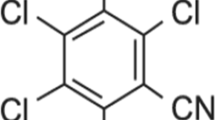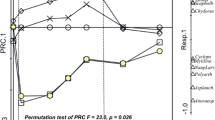Abstract
This paper describes the effects of a single and a repeated application of the organophosphorus insecticide chlorpyrifos on zooplankton and phytoplankton communities in outdoor microcosms in Thailand. Treatment levels of 1 μg L−1 were applied once or twice with a 2-week interval. Both treatments led to a significant decrease in cladocerans followed by an increase in rotifers, although the extent by which species were affected was different. Ceriodaphnia cornuta was the most responding cladoceran after the first treatment, while Moina micrura responded most to the second. This is explained by differences in the growth phase of M. micrura at the time of application and an increase in Microcystis abundance over the course of the experiment. Several phytoplankton taxa either increased or decreased as a result of the chlorpyrifos-induced changes in zooplankton communities. Even though chlorpyrifos disappeared fast from the water column, effects on plankton communities persisted till the end of the experiment (42 days) when the insecticide concentrations had dropped below the detection limit. This was presumably due to the increasing population trend of Microcystis, favouring rotifers over cladocerans.







Similar content being viewed by others
References
Ariyadej C, Tansakul R, Tansakul P, Angsupanich S (2004) Phytoplankton diversity ad its relationship to the physico-chemical environment in the Banglang reservoir, Yala province. Songklanakarin J Sci Technol 26:595–607
Bergquist AM, Carpenter SR, Latino JC (1985) Shifts in phytoplankton size structure and community composition during grazing by contrasting zooplankton assemblages. Limnol Oceanogr 30:1037–1045
Bonnet MP, Poulin M (2002) Numerical modelling of the planktonic succession in a nutrient-rich reservoir: environmental and physiological factors leading to Microcystis aeruginosa dominance. Ecol Model 156:93–112
Boonsom J (1984) The freshwater zooplankton of Thailand (Rotifera and Crustacea). Hydrobiologia 113:223–229
Campbell IC, Parnrong S (2001) Limnology in Thailand: present status and future needs. Verhandlungen der Internationale Vereinigung fur Theoretische und Angewandte Limnologie 27:2135–2141
Castillo LE, Martínez E, Ruepert C, Savage C, Gilek M, Pinnock M, Solis E (2006) Water quality and macroinvertebrate community response following pesticide applications in a banana plantation, Limon, Costa Rica. Sci Total Environ 367:418–432
Daam MA, Crum SJH, Van den Brink PJ, Nogueira AJA (Accepted with revisions) Fate and effects of the insecticide chlorpyrifos in outdoor plankton-dominated microcosms in Thailand. Accepted pending revisions by Environ Toxicol Chem
Dokulil MT, Teubner K (2000) Cyanobacterial dominance in lakes. Hydrobiologia 438:1–12
Dumont HJ (1994) On the diversity of the Cladocera in the tropics. Hydrobiologia 272:27–38
EU (1997) Council directive 97/57/EC of September 21:1997; Establishing Annex VI to directive 91/414/EEC concerning the placing of plant protection products on the market. Off J Eur Commun L265:87–109
Fernando CH (2002) Zooplankton and tropical freshwater fisheries. In: Fernando CH (ed) A guide to tropical freshwater zooplankton. Backhuys Publishers, Leiden, The Netherlands, pp 255–280
Ferrão-Filho A, Domingos P, Azevedo SMFO (2002) Influences of a Microcystis aeruginosa Kützing bloom on zooplankton populations in Jacarepaguá Lagoon (Rio de Janeiro, Brazil). Limnol Ecol Manage Inland Waters 32:295–308
Gopal B (2005) Does inland aquatic biodiversity have a future in Asian developing countries? Hydrobiologia 542:69–75
Hanazato T, Yasuno M (1987) Evaluation of Microcystis as food for zooplankton in a eutrophic lake. Hydrobiologia 144:251–259
Hanazato T, Yasuno M (1990) Influence of time of application of an insecticide on recovery patterns of a zooplankton community in experimental ponds. Arch Environ Con Tox 19:77–83
Heckman CW (1979) Rice field ecology in Northeastern Thailand. The effect of wet and dry seasons on a cultivated aquatic ecosystem. Dr. W. Junk Publishers, The Hague, The Netherlands
Henriques W, Russel DJ, Lacher TE Jr, Kendall RJ (1997) Agrochemical use on banana plantations in Latin America: perspectives on ecological risk. Environ Toxicol Chem 16:91–99
Hommen U, Veith D, Dülmer U (1994) A computer program to evaluate plankton data from freshwater field tests. In: Hill IR, Heimbach F, Leeuwangh P, Matthiessen P (eds) Freshwater field tests for hazard assessment of chemicals. Lewis Publishers, Boca Raton, FL, pp 503–513
Jungbluth F (2000) Economic analysis of crop protection in citrus production in central Thailand. Pesticide policy publication series, special issue no. 4. University of Hannover, Hannover, Germany
Kalff J, Watson S (1986) Phytoplankton and its dynamics in two tropical lakes: a tropical and temperate zone comparison. Hydrobiologia 138:161–176
Kersting K, Van Wijngaarden RPA (1992) Effects of chlorpyrifos on a microecosystem. Environ Toxicol Chem 11:365–372
Kurmayer R, Christiansen G, Chorus I (2003) The abundance of microcystin-producing genotypes correlates positively with colony size in Microcystis sp. and determines its microcystin net production in Lake Wannsee. Appl Environ Microbiol 69:787–795
Kutikova LA (2002) Rotifera. In: Fernando CH (ed) A guide to tropical freshwater zooplankton. Backhuys Publishers, Leiden, The Netherlands, pp 23–68
Lacher TE Jr, Goldstein MI (1997) Tropical Ecotoxicology: status and needs. Environ Toxicol Chem 16:100–111
Lampert W (1987) Laboratory studies on zooplankton-cyanobacteria interactions. New Zeal J Mar Fresh Res 21:483–490
Maltby L, Blake N, Brock TCM, Van den Brink PJ (2005) Insecticide species sensitivity distributions: the importance of test species selection and relevance to aquatic ecosystems. Environ Toxicol Chem 24:379–388
Moed JR, Hallegraeff GM (1987) Some problems in the estimation of chlorophyll-a and phaeopigments from pre- and post-acidification spectrophotometric measurements. Int Rev Ges Hydrobio 63:787–800
Naddy RB, Johnson KA, Klaine SJ (2000) Response of Daphnia magna to pulsed exposures of chlorpyrifos. Environ Toxicol Chem 19:423–431
Peerapornpisal Y (1996) Phytoplankton seasonality and limnology of the three reservoirs in the Huai Hong Khrai Royal Development Study Centre, Chiang Mai, Thailand. Doctoral thesis Innsbruck University, Austria
Pongswat S, Thammathawom S, Peerapornpisal Y, Thanee N, Somsiri C (2004) Diversity of phytoplankton in the Rama IX lake, a man-made lake, Pathumthani province, Thailand. ScienceAsia 30:261–267
Racke KD (1993) Environmental Fate of Chlorpyrifos. Rev Environ Contam Toxicol 131:1–150
Sanoamuang L (2001) Diversity of freshwater zooplankton in Thailand. BRT Research Reports, pp 1–16
Satapornvanit K, Baird DJ, Little DC, Milwain GK, Van den Brink PJ, Beltman WHJ, Nogueira AJA, Daam MA, Domingues I, Kodithuwakku SS, Perera MWP, Yakupitiyage A, Sureshkumar SN, Taylor GJ (2004) Risks of pesticide use in aquatic ecosystems adjacent to mixed vegetable and monocrop areas in Thailand. Australasian J Ecotoxicol 10:85–95
Segers H (2001) Zoogeography of the Southeast Asian Rotifera. Hydrobiologia 446/447:233–246
Ter Braak CJF, Smilauer P (2002) CANOCO reference manual and CanoDraw for windows user´s guide. Software for canonical community ordination (version 4.5). Microcomputer Power, Ithaca NY, USA
Thapinta A, Hudak PF (2000) Pesticide use and residual occurrence in Thailand. Environ Monit Assess 60:103–114
Tonmanee N, Kanchanakool N (1999) Agricultural diffuse pollution in Thailand. Water Sci Technol 39:61–66
Van den Brink PJ, Ter Braak CJF (1998) Multivariate analysis of stress in experimental ecosystems by Principal Response Curves and similarity analysis. Aquat Ecol 32:163–178
Van den Brink PJ, Ter Braak CJF (1999) Principle Response Curves: analysis of time-dependant multivariate responses of a biological community to stress. Environ Toxicol Chem 18:138–148
Van den Brink PJ, Hattink J, Bransen F, Van Donk E, Brock TCM (2000) Impact of the fungicide carbendazim in freshwater microcosms. II. Zooplankton, primary producers and final conclusions. Aquat Toxicol 48:251–264
Van den Brink PJ, Sureshkumar SN, Daam MA, Domingues I, Milwain GK, Beltman, WHJ, Perera MWP, Satapornvanit K (2003) Environmental and human risks of pesticide use in Thailand and Sri Lanka: result of a preliminary risk assessment. Alterra-Report 789, Wageningen, The Netherlands
Van Donk E, Abdel-Hamid MI, Faafeng BA, Källqvist T (1992) Effects of Dursban®4E and its carrier on three algal species during exponential and P-limited growth. Aquat Toxicol 23:181–191
Van Wijngaarden RPA, Leeuwangh P, Lucassen WGH, Romijn K, Ronday R, Van der Velde R, Willigenburg W (1993) Acute toxicity of chlorpyrifos to fish, a newt, and aquatic invertebrates. Bull Environ Contam Toxicol 51: 716–723
Van Wijngaarden RPA, Van den Brink PJ, Oude Voshaar JH, Leeuwangh P (1995) Ordination techniques for analyzing response of biological communities to toxic stress in experimental ecosystems. Ecotoxicology 4:61–77
Van Wijngaarden RPA, Brock TCM, Van den Brink PJ (2005) Threshold levels of insecticides in freshwater ecosystems, a review. Ecotoxicology 14:353–378
Victor R (2002) Ostracoda. In: Fernando CH (ed) A guide to tropical freshwater zooplankton. Backhuys Publishers, Leiden, The Netherlands, pp 189–233
Vijaranakorn T, Nutniyom P, Chantara S (2004) Distribution of Microcystis aeruginosa Kutz., microcystin concentrations and water quality of Mae Kuang Udomtara Reservoir, Chiang Mai Province. Chiang Mai J Sci 31:69–84
Acknowledgements
This study was funded by the Portuguese government through FCT (scholarship SFRH/ BD/ 8213/ 2002) and the European Commission’s INCO: International Scientific Cooperation Projects (MAMAS project, contract number ICA4–2000-10247). The authors are indebted to the staff at the AIT hatchery for technical assistance, and to Steven Crum for valuable contributions to the development of the chlorpyrifos analysis method.
Author information
Authors and Affiliations
Corresponding author
Appendix
Appendix
Rights and permissions
About this article
Cite this article
Daam, M.A., Van den Brink, P.J. & Nogueira, A.J.A. Impact of single and repeated applications of the insecticide chlorpyrifos on tropical freshwater plankton communities. Ecotoxicology 17, 756–771 (2008). https://doi.org/10.1007/s10646-008-0227-8
Received:
Accepted:
Published:
Issue Date:
DOI: https://doi.org/10.1007/s10646-008-0227-8




